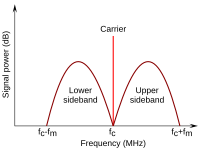
Photo from wikipedia
We experimentally demonstrate a heterodyne W-band fiber-wireless system using a twin single-side-band orthogonal frequency division multiplexing (Twin-SSB-OFDM) transmission scheme with low-cost electrical filters. The transmission scheme is proposed to halve… Click to show full abstract
We experimentally demonstrate a heterodyne W-band fiber-wireless system using a twin single-side-band orthogonal frequency division multiplexing (Twin-SSB-OFDM) transmission scheme with low-cost electrical filters. The transmission scheme is proposed to halve the required sampling rate of the baseband receiver. Moreover, since the W-band signal generation is based on optical heterodyne with nonideal laser sources, there is a time-varying carrier frequency offset (CFO) in the system. To mitigate the CFO effect and simultaneously realize down-conversion, a blind carrier recovery method is proposed and validated in the system. The experimental results show that after 22-km SSMF transmission and 1-m wireless transmission, the system can achieve a 40.07 Gb/s data rate with a bit-error-ratio (BER) below 3.8 × 10−3 when using a two-channel 12-GSa/s arbitrary waveform generator (AWG) as transmitter and two emulated 12-GSa/s baseband receivers. In addition, by setting the AWG at 5-GSa/s and using a 5-GSa/s real-time field programmable gate array (FPGA)-based receiver, an additional experiment is carried out by implementing the proposed method in the real-time receiver. Although the frequency swing of the intermediate frequency (IF) carrier of the received signal is up to ∼300 MHz, the system can also achieve a relatively stable transmission performance. The additional experiment further verifies the effectiveness and practical feasibility of the proposed carrier recovery method and the Twin-SSB-OFDM transmission scheme.
Journal Title: Journal of Lightwave Technology
Year Published: 2018
Link to full text (if available)
Share on Social Media: Sign Up to like & get
recommendations!